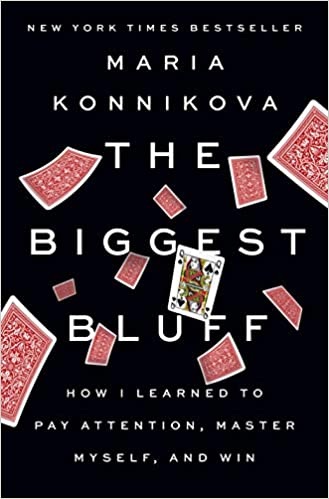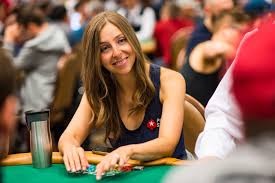
The Biggest Bluff: How I Learned to Pay Attention, Master Myself, and Win by Maria Konnikova chronicles her journey as a PhD psychologist and journalist into the world of professional poker. She starts with zero knowledge and experience and with the help of mentors and lots of hard work becomes a poker champion. While the framework for this book is the game of poker, each chapter features generalizations that we can all draw on to add quality to our lives.

A Prelude – Las Vegas, July 2017
- We start with a story from the World Series of Poker, which is The World Cup, The Masters, and The Super Bowl for poker players. Anyone can enter as long as they put up the $10,000 entry fee. This can be a lifetime dream for many. As play continues Maria’s seat sits empty while the dealer takes the anti for each hand from her piles of chips and tosses her cards into the discard pike known as “the muck.” She is in the bathroom curled up in a fetal position on the floor after barfing her brains out due to eating some bad guacamole. At the time she understood the line between skill and luck. The message is that you can’t calculate for dumb bad luck and you can’t bluff chance.
Ante UP – New York, Late Summer 2016
- Here we meet Erik Sidel, one of the top poker players of all time. Maria approaches him to see if he will mentor her for her experiment, which involves seeing if a psychologist with zero knowledge of poker can have success after spending only a year learning the game. Eric knows that most people who get serious about the game come at it thinking a deep knowledge of math is the most important attribute. He knows that a deep understanding of psychology is more important as the necessary math his not that hard to master. He also sees Maria’s language skills as another key attribute. (She is fluent in English and Russian, was fluent in Spanish and French, and can get by in Italian.) Eric accepts the challenge and it’s game on. You don’t play poker, you play the world.
The Birth of a Gambler – Boston, Fall 2016
- Life is a gamble. It may not seem like playing poker, but in some sense, much of life features less control than you have as a skilled poker player. Here we have a conversation with Maria’s grandmother (Baba Anna) who is very disappointed that Maria is taking up poker rather than a “real job.” Skilled stock pickers do no better than chance in the long run while professional poker players routinely outplay amateurs. In poker, the best hand doesn’t always win. This sets it apart from other games. The process of betting gets your full attention unlike making a decision where no bet is involved. This allows you to benefit from life’s decisions as well. Accurate probabilistic thinking is rare, but it is necessary for success in poker. Like people who predict the weather and horse races, poker players get immediate feedback and have no one to blame but themselves.
The Art of Losing – New York, Fall 2016
- Eric’s step one is to read the poker books by Dan Harrington, cousin to the golfer Padraig Harrington. Next, you need to watch streams with real hands being played by the best players. Sign up for the Run It Once a poker coaching site. Then start playing for real online for tiny stakes that can gradually get bigger. From there you can proceed to small tournaments and then move up to bigger ones. You need a balance between aggressive and conservative playing so that your opponents can’t figure you out. You also need to keep track of everyone’s stack size.
- Here we encounter the importance of learning from losing. (Doug: The concept of learning from failure is found in many of the other books I have summarized.) You have to constantly think, analyze, and stay objective. This is hard to do. This means that you never take things personally as you treat triumph and disaster the same. Disaster can bring true objectivity. Eric teaches Maria that there is no certainty, only thought. There are no right answers regarding any situation without a greater context. Self-awareness and self-discipline should be your twin goals.
The Mind of a Strategist – New York, Late Fall 2016
- Maria starts practicing online, but in order to do so, she has to take a train from Manhattan to New Jersey as online poker is illegal in New York State. She picks a puppy as her avatar and “psychchic” as her screen name. She describes a hand she loses and finds that she made a mistake by trying to copy a hand Eric had once and acted aggressively so as not to look weak. Time is an issue online and in real tournaments as it is in real life. In both cases, you want to use the time you have to think things through, but not act impulsively as time starts to run out. When playing you want to be the last one to act as that will give you maximum information.
- The military analogy applies here. You need to know the enemy and survey the nature of the board in each hand. Like a general, you need to decide just how many of your troops you need to deploy. Everything from a scout to every soldier you have is in play. Your strategy cannot be predetermined. Another analogy is that of a jazz band where once it’s your turn you have to decide what to play.
- If you only bet when you have top cards your opponents will figure that out and you won’t win much. You will lose more as you won’t often have top cards. This is why you have to bluff on occasion. Maria tells the story of getting an offer to write an article about what she was doing. She said no several times until she got an offer of $3/word. Like sometimes in poker, she got more out of her hand then she thought she could.
DrDougGreen.com If you like the summary, buy the book
Tags: Eric Sidel, Maria Konnikova, Phil Galford, Poker, Texas hold 'em





